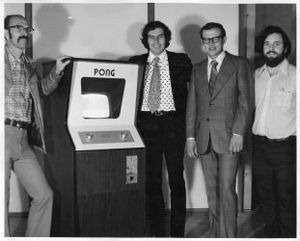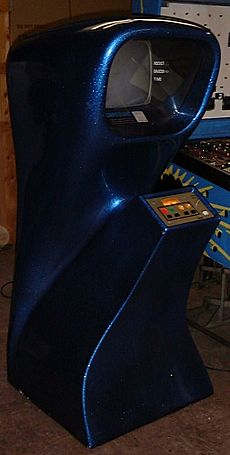Ted Dabney facts for kids
Quick facts for kids
Ted Dabney
|
|
|---|---|

Ted Dabney (left) in 1972 with a Pong arcade cabinet and fellow Atari employees Nolan Bushnell, Fred Marincic and Allan Alcorn
|
|
| Born |
Samuel Frederick Dabney Jr.
May 2, 1937 |
| Died | May 26, 2018 (aged 81) Clearlake, California, U.S.
|
| Occupation | Electrical engineer |
| Known for | Co-founder of Atari, Inc., co-creator of Computer Space |
| Spouse(s) | Carolyn Dabney |
Samuel Frederick "Ted" Dabney Jr. (May 2, 1937 – May 26, 2018) was an American electrical engineer. He helped start Atari, Inc. with Nolan Bushnell. Ted Dabney is known for creating the basic video technology used in early video games like Computer Space and the very popular Pong. Pong was one of the first and most successful arcade games ever made.
Contents
Ted Dabney's Early Life and Learning
Ted Dabney was born in San Francisco, California. He went to John A. O'Connell High School of Technology, where he learned about drafting. This helped him get a job with the California Department of Transportation when he was still a teenager. Later, he got his high school diploma from San Mateo High School. A math teacher there helped him get interested in electronics and computers.
After high school, Ted joined the United States Marine Corps. During his three years in the Marines, he took courses in electronics. This made him even more interested in the field. He later worked at Bank of America, where he helped keep their electronic accounting machines running.
Starting a Career in Computers

In 1961, Ted Dabney started working at Ampex. At Ampex, he got involved with early video products, like systems that used video cameras. Around 1969, Nolan Bushnell also joined Ampex. Ted and Nolan became good friends.
Nolan Bushnell had an idea for a fun place with games and robots, like a carnival. He talked about this idea with Ted. After seeing a computer game called Spacewar! at a university lab, they thought about making coin-operated video games. People could pay to play these games.
Creating Atari and Early Games
In 1971, Ted Dabney and Nolan Bushnell formed a partnership called Syzygy. When they decided to make it a bigger company, they found another company already had that name. So, they chose the name Atari, Inc.. "Atari" is a term from the game Go, similar to "check" in chess. Both Ted and Nolan loved playing Go.
Their first game was Computer Space. Ted Dabney designed a special video circuit for the game. This circuit used affordable parts from a regular television set instead of an expensive computer. Nolan Bushnell designed the game's cabinet. They worked with a company called Nutting Associates to build many of these games.
Nolan also convinced Al Alcorn, another friend from Ampex, to join Atari. Alcorn used Ted Dabney's video circuit idea to create the programming for Atari's next game, Pong. Ted built the part of the cabinet where players put in coins. When their first Pong machine was a big hit, they started making many more. Ted oversaw the manufacturing process. Pong became the first really successful arcade game.
Leaving Atari and Later Work
As Pong became very popular, Ted Dabney felt that Nolan Bushnell and Al Alcorn were getting all the credit. He also found out that Nolan had patented his video circuit idea without including Ted. Nolan also gave Ted a lower position at Atari and didn't include him in important meetings.
Around March 1973, Ted Dabney left Atari. He sold his share of the company for a good amount of money. Even after leaving Atari, Ted continued to help Nolan Bushnell with some of his new projects. These included Pizza Time Theater (which later became Chuck E. Cheese's) and Catalyst Technologies. Ted also worked for other companies like Raytheon and Fujitsu.
He even started his own video game company, Syzygy Game Company. There, he made games that Nolan used for his Pizza Time Theaters. One game was a quiz game based on the writer Isaac Asimov. Ted also helped create the automated ticket system used in the restaurants. When Pizza Time Theater ran into trouble and Nolan couldn't pay Ted what he owed, Ted closed his company and ended his friendship with Nolan. Ted then worked at Teledyne for about ten years before leaving the computer industry.
Life After Gaming
After leaving the computer industry, Ted and his wife, Carolyn, managed a grocery store and later a deli. They moved to Washington state for a while but later returned to California.
For many years after leaving Atari, Ted Dabney was not well-known. His important contributions to Atari and early video games were mostly forgotten until 2009. In 2009, Ted gave an interview where he talked about his role in Atari's early days. He also spoke with the Computer History Museum in 2012 to share his story.
In March 2018, people from the Smithsonian Institution interviewed Ted Dabney for eight hours at his home. They wanted to record his side of the story about the early days of video games.
Ted Dabney passed away on May 26, 2018, at his home in Clearlake, California.
Images for kids
See also
 In Spanish: Ted Dabney para niños
In Spanish: Ted Dabney para niños



